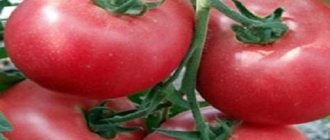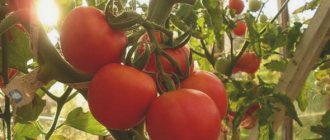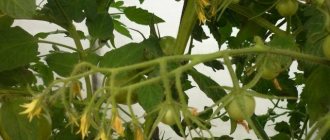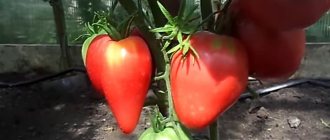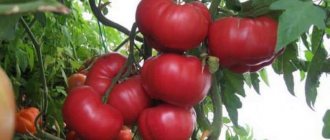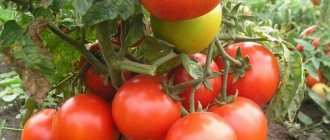Description
This is an early ripening variety of red tomatoes, for growing in unheated film greenhouses and open ground. The variety grows up to 90 cm in height. The harvest is harvested from July to September. The characteristics of tomatoes seven 40 allow it to be used for canning.
Tomato seven forty reduces cholesterol levels in the blood and is recommended for diseases of the gastrointestinal tract (easily digested and absorbed).
Varieties of this type have the following properties:
- High yield – 15 kg/m2;
- Resistance to many diseases and viruses;
- Fragrant and tasty;
- Flameproof.
Fruit characteristics:
- Rounded-elongated shape;
- Large ones weighing up to 300 g;
- Dense;
- Smooth;
- Long shelf life;
- Resistant to cracking.
Description and characteristics of the variety
Seven forty F1 is a low-growing, large-fruited hybrid for open ground and spring film unheated greenhouses. It was bred by breeder Mashtakov, the author of other popular varieties and hybrids: Black Prince, Infinity, Black Moor. Mashtakov lives and works in the Rostov region, so his cultivars are perfectly suited for areas with arid, hot climates.
The hybrid is recommended for cultivation in the regions:
- North and North-West of Russia,
- Volgo-Vyatsky,
- Central Black Earth Region
- North Caucasus,
- Middle Volga,
- Central.
The cultivar was included in the State Register in 2010.
The fruits of the hybrid are flat-round, hard, smooth, bright red. The taste is excellent.
The fruits ripen on the 98th day after full germination, so experts classify the variety as early ripening. It is noteworthy that despite the large fruit, the harvest is still early.
Plants stop lengthening on their own, having reached a height of 70-90 cm. The bushes form powerful and require mandatory garter.
Sowing and care
Tomatoes are very heat-loving, so they are grown only in seedlings. Seeds are planted in March-April, 60 days before planting in a permanent place. Growing requires following some rules. Seeds are germinated in damp gauze bags at room temperature. Those seeds that have sprouted must be planted in the ground and covered with film.
Afterwards, they are placed in separate jars at the rate of one root per jar. It is necessary to water frequently, 2-3 times a week.
Planting can be done only after the end of frost and the formation of permanent warm weather, otherwise your plants will die. It is usually carried out in May-June at the rate of 3 roots per 1 m2. Watering is carried out every other day.
It is necessary to water tomatoes at the root. On particularly hot days, it is possible to spray the entire stem. Two weeks after planting, you can apply fertilizer. The following fertilizing should be carried out during abundant flowering, fruit set and ripening. It is imperative to carry out regular stepsoning. Fruits appear in 3-4 weeks, 6 pieces in a nest. They begin to sing after 2-3 weeks.
See also
Characteristics and description of the tomato variety Novichok, yield and cultivationRead
In the middle or end of August, it is necessary to stop the growth of the stem due to the end of the season and allow all the formed ovaries to mature. To do this, cut off the tops and monitor the formation of stepsons, which also need to be removed. Before the first frost, it is necessary to collect all the tomatoes, regardless of their ripeness. Otherwise, your harvest may be lost.
Tomato seven forty reviews photo yield
Tomatoes are the most common vegetable crop along with potatoes and cucumbers, which every self-respecting gardener considers it his duty to plant and grow.
Currently, a huge variety of varieties of different colors and ripening periods have been developed. One of them is the Seven Forty F1 tomato, which has gained popularity among farmers due to its taste and other properties, as well as reviews.
Description of the variety
Tomato Seven forty F1 is one of the relatively new proprietary hybrid varieties. The F1 marking reminds us of hybridity. It means that the plant was obtained by crossing two maternal samples in order to inherit the dominant (preferential) qualities of both.
It should be noted that these above-mentioned qualities are inherited only by the first generation, and therefore it is not advisable to collect the seeds of grown hybrid tomatoes for further planting. The harvest may not turn out at all with the qualities that were expected from it.
Excellent harvest of tomatoes (photo)
The characteristics of the Seven Forty F1 tomato, according to the description and reviews, determine its popularity:
- pleasant taste and aroma;
- amicable maturation;
- early ripening periods;
- heat resistance;
- resistance to most common pests and diseases;
- high keeping quality of fruits.
The bushes, according to the characteristics and reviews, grow tall - from 70 to 90 cm in height. In this regard, they require a garter, otherwise they will fall to the ground under the influence of their own weight. Growing tomatoes is possible both in greenhouse conditions and in open ground.
The variety is characterized by early ripening; the fruits can be harvested as early as the end of July. Grown tomatoes have a round shape, bright red color and a dense, fleshy consistency, making them well suited for use in canning.
The high taste qualities of this variety allow you to enjoy eating its fruits freshly picked. They can also be used for culinary purposes.
Tomato variety Seven forty F1 is distinguished by its yield - up to 16 kg per square meter of planting area.
Rules for planting and care
This type of tomato is suitable for every garden (photo)
Growing tomatoes begins with obtaining seedlings. First, the seeds are germinated in a damp cloth on the windowsill, then planted in containers with fertile, light soil. The containers are covered with film or glass and placed in a warm place.
When shoots appear, the covering material can be removed. Plantings need to be provided with good lighting and regular watering.
The first true leaves of the seedlings appear after 5-7 days. You need to wait another 3-4 days for the plants to become strong enough to pick them.
Tomato picking is carried out to strengthen its root system and increase bushiness.
Seedlings are planted in separate containers (you can take plastic cups from yogurt or ice cream, cut plastic bottles). It is not recommended to pinch the roots, as this weakens the plant.
The pots should be trimmed so that their volume is enough for a couple of weeks. If there is a lot of free soil in the container that is not occupied by roots, bacteria may grow in it, and the soil itself may become acidic.
Once the seedlings reach a height of 15-20 cm, they can be planted in an outdoor greenhouse, if possible. In the absence of daytime frosts, the greenhouse is opened slightly during the day. This gives the tomatoes additional access to oxygen and at the same time promotes their hardening.
When the threat of sudden May frosts has passed, and the air and soil temperatures do not drop below +10°C, the seedlings can be planted in open ground.
For planting, dig holes in the amount of three per square meter. Plants are buried down to the first leaf and the soil is slightly compacted. Then the plantings are watered.
Caring for Seven Forty F1 tomatoes involves timely watering, loosening the soil, fertilizing it, removing weeds and preventing possible diseases. As the tomatoes grow, they need to be staked to ensure stability.
Peeling (removing side shoots from the bush) should be carried out periodically to stimulate the formation of fruit ovaries.
Customer Reviews
Tomato Seven forty F1 enjoys positive reviews among amateur farmers. Plants are little susceptible to diseases and pests, are not fussy to care for, and the harvest grows tasty and beautiful.
Thanks to this, the variety has gained popularity among gardeners, despite the fact that it was developed relatively recently.
While watching the video you will learn about growing tomatoes.
Hybrid tomatoes are characterized by a purple marker color with a bronze tint (anthocyanin color). Its absence indicates that the seeds do not meet the quality indicators of current standards.
During the formation of 1-2 true leaves, diving is carried out in separate containers. For this purpose, peat pots are used, with which it is convenient to transfer formed seedlings with 1 peduncle to a permanent place.
Growing a hybrid requires compliance with the rules of agricultural technology. It is recommended to place 3 bushes per 1 m². For normal development, seedlings need access to sunlight.
The plant requires moderate watering as the topsoil dries out. You can provide drip irrigation and prevent the growth of weeds using non-woven fiber. The use of organic materials (straw, leaves) as mulch serves as a source of nutrition for tomatoes during the period of growth and fruiting.
The hybrid is responsive to the application of complex fertilizers. To ensure a balance of moisture and air near the root system, the soil is periodically loosened. Hilling up bushes stimulates the formation of additional roots, which improves plant nutrition.
The bushes grow in 1-2 stems, and the stepsons are periodically removed. Plants require tying to a support.
Opinions and recommendations of gardeners
Reviews from vegetable growers indicate the positive characteristics of the variety. The hybrid is resistant to cracking during ripening, adapts well to high temperatures, and can easily be transported over distances.
Valery Efimov, 53 years old, Voronezh.
Last season, I planted the Seven Magpie tomato in the greenhouse for the first time. I was pleased with the opportunity to pick fresh tomatoes from the bush for a long period of time. The fruits are very tasty, aromatic, with dense pulp. Excellent for canning and processing into sauce.
Margarita Antonova, 56 years old, Adler.
Seven forty tomatoes were planted in open ground. I purchased the seeds from a well-known brand. I was convinced of the quality of the material after the sprouts appeared, which had a characteristic purple hue. Before sowing, the seeds were treated with a growth stimulator. The variety pleased with its taste, high yield, fruits of the same size, with dense pulp. The description fully corresponds to the information on the packaging. The hybrid is highly resistant to diseases and biological pests.
Tomato Seven forty F1 can be grown in regions with temperate climates. This is a first generation hybrid. It is resistant to diseases and produces transportable, tasty, abundant fruits. The tomato is suitable for summer residents who have the most primitive greenhouses or those who prefer to grow tomatoes without shelter.
| Height | Landing location | Ripening time | Fruit color | Fruit size | Origin | Fruit shape |
| Medium height | Open ground | Early ripening | Reds | Large | Hybrid | Flat-round |
Description and characteristics of the variety
Seven forty F1 is a low-growing, large-fruited hybrid for open ground and spring film unheated greenhouses. It was bred by breeder Mashtakov, the author of other popular varieties and hybrids: Black Prince, Infinity, Black Moor. Mashtakov lives and works in the Rostov region, so his cultivars are perfectly suited for areas with arid, hot climates.
The hybrid is recommended for cultivation in the regions:
- North and North-West of Russia,
- Volgo-Vyatsky,
- Central Black Earth Region
- North Caucasus,
- Middle Volga,
- Central.
The cultivar was included in the State Register in 2010.
The fruits of the hybrid are flat-round, hard, smooth, bright red. The taste is excellent.
The fruits ripen on the 98th day after full germination, so experts classify the variety as early ripening. It is noteworthy that despite the large fruit, the harvest is still early.
Plants stop lengthening on their own, having reached a height of 70-90 cm. The bushes form powerful and require mandatory garter.
Advantages and disadvantages
- resistant to viruses and fusarium,
- great taste
- high productivity,
- early ripeness,
- no greenhouses needed.
- requires a high-quality garter,
- have to take stepson
- not suitable for processing into juice.
Productivity
From 1 sq. m produce almost 16 kg of marketable fruits. The overall fees are much higher.
Features of cultivation and storage
To prevent the hybrid from losing its advantage - early ripeness, it is grown through seedlings, sowing 55-60 days before transplanting into open ground. In the middle zone, you can sow throughout March with transplanting to unprotected beds at the end of May - beginning of June. Harvesting begins in July. The fruits ripen until mid-September.
The planting pattern is 40 by 60 cm. The bushes must be pinched, leaving only one lateral shoot extending above the first flower cluster. The fruits can be stored for a short time.
Planting and care
Before sowing, the seeds must be treated in the growth stimulator "Epin" (1 drop per 50 ml, holding time 2-4 hours). When shoots appear, the plants are transferred to a cool place with a temperature of 14-16 degrees, where they are kept for a week. This helps harden the tomatoes and makes their root system strong. Picking in the phase of 2 true leaves is required.
If the bushes are planted in open ground early, it is necessary to provide for the possibility of covering them with film during late spring frosts. When warm weather sets in, the film can be removed and the plants tied to a trellis or stakes. In open ground, tomatoes form two stems.
You will need 2 feedings:
- when the seedlings planted in the garden grow stronger and begin to grow - a tablespoon of urea per 10 liters of water per 10 bushes,
- during mass flowering - a tablespoon of azofoska per 10 liters of water, per 10 plants.
What to fear
Tomatoes can be affected by pests and diseases. Pests rarely attack tomatoes, but spraying them with special solutions will protect your plant. They can be bought at any department store.
The main danger for tomatoes is disease. The most common of them: late blight, leaf spot, tobacco mosaic, blossom end rot. But do not be afraid: the new hybrid tomato seven 40 is resistant to the listed diseases and nothing threatens your harvest.
Adviсe
- The soil for growing tomatoes must be prepared in advance, preferably in the spring. Tomatoes love organic fertilizers (compost, manure, peat), potassium, phosphorus. If the soil is acidic, you need to add lime.
- When planting in a greenhouse, deep holes must be made for each tomato, just like for cabbage. This is necessary so that the water gets directly to the root, and does not spill around like a river.
- When planting a root, it must be deepened to the first leaf. This way the root system will be larger and the plant will be more stable.
Customers' opinions
Here are reviews from some buyers of this variety.
- Maxim: I planted it for the first time. Very tasty. High yield. I will plant next year.
- Olga: The description matches. Not fussy, high yield. I planted 5 roots in the greenhouse for testing. Almost every day I picked several ripe tomatoes. I recommend it to everyone. Next year I will plant the entire greenhouse with this variety. Very pleased.
- Anton: I planted it on the balcony. It does not affect the yield - everything is as written on the package. I recommend this variety of tomatoes to everyone.
- Masha: I decided to start my experience in growing tomatoes with this variety. I only planted 10 roots. I was afraid they wouldn't grow as much as they should. And it turned out to be wrong. We grew up together. There are many ovaries. There were no pests. Very easy to care for: just water and tie up. Next year I will plant more.
- Ekaterina: I am an experienced gardener. But even with this variety I was pleasantly surprised. The tomatoes are even and ripening together. Almost every day I collected so many ripe tomatoes that it was enough to eat and make 1 jar for pickling.
- Mikhail: I planted this variety of tomatoes in the garden in a film greenhouse. Good variety. The tomatoes grew smooth and tasty. They ripened already in early July.
See also
Characteristics and description of the Black Prince tomato variety, its yieldRead
The Seven Forty tomato hybrid will provide you with a large tomato harvest and no hassle in dealing with various pests. By watering and caring for it on time, it will respond to you with gratitude. And the tasty and aromatic fruits will not leave anyone indifferent. Even in winter, when you try a jar of pickled or canned tomatoes, they will be just as tasty and aromatic as in summer.
Advantages of a hybrid
Tomato Seven forty F1 belongs to the first generation hybrids. The variety is intended for cultivation in open ground conditions, film greenhouses. An early ripening tomato begins to bear fruit 95-100 days after germination.
During the growing season, the determinate hybrid reaches a height of 70-90 cm. The first peduncle is formed at the level of 5-7 leaves, and subsequent ones are formed at intervals of 1-2 leaves. The inflorescence is simple, 5-7 fruits ripen in the cluster.
The description of the 7/40 variety is associated with the characteristics of the fruits being round in shape. In the ripe phase, tomatoes acquire an intense red color. The stalk has no green spot. When cut horizontally, many chambers with seeds are observed.
The fruits have smooth skin, dense pulp, intense tomato aroma and taste. The fruit weight reaches 220-250 g. The crop yield is 15.5-16 kg per 1 m².
The hybrid is resistant to most diseases of nightshade crops, including Alternaria, blossom-end and root rot, and tobacco mosaic virus. In cooking, the fruits are used fresh, for preparing various dishes, and pickling.
